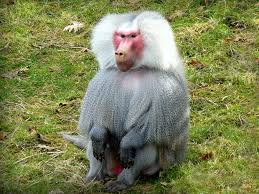
Hamadryas baboon
(Papio Hamadryas)

The hamadryas baboon is a species of baboon from the Old World monkey family. It is the northernmost of all the baboons, being native to the Horn of Africa and the southwestern tip of the Arabian Peninsula. These regions provide habitats with the advantage for this species of fewer natural predators than central or southern Africa where other baboons reside. The hamadryas baboon was a sacred animal to the ancient Egyptians and appears in various roles in ancient Egyptian religion, hence its alternative name of 'sacred baboon'.
Conservation status
Least concern
Scientific classification |
|
| Kingdom: | Animalia |
| Phylum: | Chordata |
| Class: | Mammalia |
| Order: | Primates |
| Family: | Cercopithecidae |
| Genus: | Papio |
| Specie: | Papio hamadryas |
Physical description

Apart from the striking size difference between the sexes (males are often twice as large as females), which is common to all baboons, this species also shows sexual dimorphism in coloration. The fur of males is silver-white in color and they have a pronounced cape (mane and mantle) which they develop around the age of ten, while the females are capeless and brown. Their faces range in color from red to tan to a dark brown.
Males may have a body measurement of up to 80 cm (31 in) and weigh 20-30 kg (44-66 lb); females weigh 10-15 kg (22-33 lb) and have a body length of 40-45 cm (16-18 in). The tail adds a further 40-60 cm (16-24 in) to the length, and ends in a small tuft. Infants are dark in coloration and lighten after about one year. Hamadryas baboons reach sexual maturity at about 51 mo for females and between 57 and 81 mo for males.
Group organization

The baboon has an unusual four-level social system called a multilevel society. Most social interaction occurs within small groups called one-male units or harems containing one male and up to ten females which the males lead and guard. A harem will typically include a younger "follower" male who may be related to the leader. Two or more harems unite repeatedly to form clans. Within clans, the dominant males of the units are probably close relatives of one another and have an age-related dominance hierarchy. Bands are the next level. Two to four clans form bands of up to 200 individuals which usually travel and sleep as a group. Both males and females rarely leave their bands. The dominant males will prevent infants and juveniles from interacting with infants and juveniles from other bands. Bands may fight with one another over food, etc., and the adult male leaders of the units are usually the combatants. Bands also contain solitary males that are not harem leaders or followers and move freely within the band. Several bands may come together to form a troop. Several bands in a troop also often share a cliff-face where they sleep.
Group behavior

The hamadryas baboon is unusual among baboon and macaque species in that its society is strictly patriarchal. The males limit the movements of the females, herding them with visual threats and grabbing or biting any that wander too far away. Males will sometimes raid harems for females, resulting in aggressive fights. Many males succeed in taking a female from another's harem, called a "takeover". Visual threats are usually accompanied by these aggressive fights. This would include a quick flashing of the eyelids accompanied by a yawn to show off the teeth. As in many species, infant baboons are taken by the males as hostages during fights. However, males within the same clan tend to be related and respect the social bonds of their kin. In addition, females demonstrate definite preferences for certain males, and rival males heed these preferences. The less a female favors her harem males, the more likely she will be successfully taken by a rival. Young males, often "follower" males, may start their own harems by maneuvering immature females into following them. The male may also abduct a young female by force. Either way, the male will mate with the female when she matures. Aging males often lose their females to followers and soon lose weight and their hair color changes to brown like a female. While males in most other baboon species are transferred away from their male relatives and into different troops, male hamadryas baboons remain in their natal clans or bands and have associations with their male kin.
Hamadryas baboons have traditionally been thought of having a female transfer society with females being moved away from their relatives of the same sex. However, later studies show female baboons retain close associations with their female kin throughout their lives. Females can spend about as much time with other females as they do with the harem males, and some females will even interact with each other outside of their harems. In addition, it is not uncommon for females of the same natal group to end up in the same harem. Females can still associate and help their extended families despite their interactions being controlled by the harem males.
Females within a harem do not display any dominance relationships as seen in many other baboon and macaque species. The harem males suppress aggression between the females and prevent any dominance hierarchies from arising. Despite this, some social differences between the females occur. Some females are more socially active and have a stronger social bond with the harem male. These females, known as the "central females", stay in closer proximity to the harem male then the other females. Females that spend most of their time farther from the harem male are called "peripheral females".
Reproduction and parenting

Like other baboons, the hamadryas baboon breeds aseasonally. The dominant male of a one-male unit does most of the mating, though other males may occasionally sneak in copulations, as well. Females do most of the parenting. They nurse and groom the infant and one female in a unit may groom an infant that is not hers. Like all baboons, hamadryas baboons are intrigued by their infants and give much attention to them. Dominant male baboons prevent other males from coming into close contact with their infants. They also protect the young from predators. The dominant male tolerates the young and will carry and play with them. When a new male takes over a female, she develops sexual swellings which may be an adaptation that functions to prevent the new male from killing the offspring of the previous male. When males reach puberty, they show interest in mothering young infants. They will kidnap the infants by luring them away from their harems and inviting them to ride on their backs. This is more often done by "follower" males. This kidnapping can lead to dehydration or starvation for the infant. The harem leader would retrieve the infants from their kidnappers, which is mostly an act to protect their offspring.
Zoológico de Vallarta A. C.
Leave your comments, your opinion is important to us

